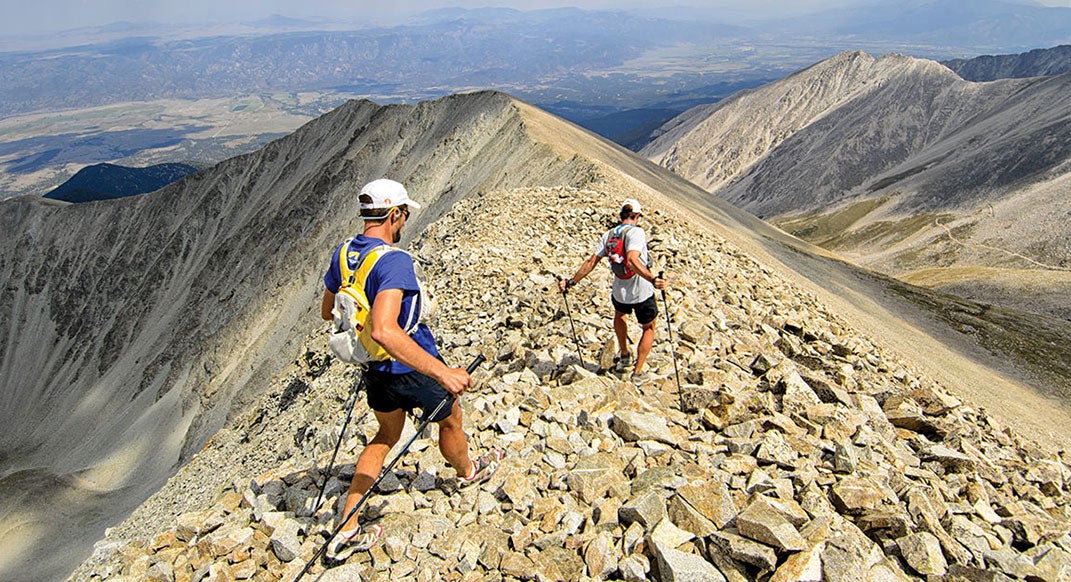Trekking Poles for Trail Runners, Reviewed

It’s just running, you say, so why encumber it with trekking poles? But analyze starting-line photos of rugged mountain ultras and even steep shorter-distance races, and you’ll notice a growing percentage of racers sporting trekking poles. So what’s all the fuss?
“Poles make a huge difference on long training runs, races and FKTs,” says Krissy Moehl, who set the Tahoe Rim Trail FKT using poles. “They can help with balance when fatigued, add power on steep climbs and keep you more upright, as opposed to pressing hands on knees.”
So, we gathered up the three top poles for trail runners: those that are super light, collapsible and fixed length, with minimal baskets, and few weight-adding features like adjustability and shock absorption. Then, we took to steep, rocky trails to see what all the fuss was about.
How to Run and Power Hike With Poles
For sizing, most websites offer a chart, but, generally, while holding the pole with your arm at your side and elbow at a 90-degree angle, your forearm should parallel the ground.
As you would a ski pole, insert your hand through the wrist strap from underneath, so that you are pushing down on the loop with the web of
your hand.
Ditch the rubber/plastic tips in favor of the grippier carbide tips.
On uphills, most people employ the single-pole technique, where you alternate poling every step, similar to classic Nordic-skiing technique, using your normal running stride.
Alternatively, to gain more power and propulsion, try a rhythmic double-pole plant, similar to that employed by Nordic skate skiers.
Adds 100-mile king Karl Meltzer, “I like to place my hands on the top of them, not in the hand straps. They work like a fulcrum, so you get more propulsion.”
For downhills, poles are not effective at adding propulsion, but can help you keep your balance, especially on steep and rugged terrain.
Beware the potential to stab yourself with a pole in the mid-section on steep downhills should you slip or lose your balance; for this reason, consider taking your hand out of the wrist strap, choking down slightly on the grip and “tick ticking” the poles at your sides for balance, rather than firmly planting and resting weight on them.
On mellow downhills and flats, either run with the poles while holding them in the middle, or break them down and stow them in your hydration pack.
Reviews
Leki Trailstick
$200 / 13.2 oz per pair (115 cm)
Available Lengths: 105-135 cm (5 cm increments)
Designed for both trail running and Nordic walking, the carbon Trailsticks have a unique wrist-strap system—the strap fits on your hand similar to a Nordic skate pole (your thumb fits through a hole and your wrist is wrapped by the strap) but can be disengaged from the pole by pushing down on the top knob and lifting up (which takes a little getting used to), freeing you to drink, eat, etc. To re-engage, simply slide the loop on the strap into the slot and click them back in. This system provided the most locked-on feel and power.
Pros
– Comfortable strap and cork-plastic grip (relatively thin so it is well suited to small hands)
– Good power transfer due to the locked-on, Trigger Shark grip/wrist-strap system
– Quick, easy deployment and breakdown mechanism
– Multiple length options, allowing for best fit
Cons
-You lose approximately four centimeters from the specified pole length due to the Trigger Shark grip/strap system (so size up accordingly)
– Can’t push off top of pole in steep terrain because locked
into strap
– Strap can feel sweaty in warm weather
Black Diamond Distance Carbon Z Trekking Poles
$160 / 10.0 oz per pair (120cm)
Available Lengths: 100-130 cm (10 cm increments)
The sleek all-carbon Distance Trekking Poles were the lightest of the trio, and got raves for their barely there, nimble feel.
Pros
– Super lightweight
– Easy-to-adjust, comfortable wrist strap
– Comfortable foam grip with extension
for choking down
– Relatively large grip top for pushing off of
– Quick, easy deployment and breakdown mechanism
Con
-Only comes in 10-centimeter length increments
Helinox Passport Tension Lock
$150 / 11.0 oz per pair (115 cm)
Available Lengths: 115, 125
Composed of DAC’s proprietary aluminum alloy, the Passport Tension Lock poles offer light weight, durability and affordability. Testers gave extra points for the handy strap that cinches the pole together when collapsed.
Pros
– Easy-to-adjust wrist straps
– Nifty hook-and-loop strap cinches poles together for stowing
– Comfortable foam grip with extension for choking down
– Quick, easy deployment and breakdown mechanism
Cons
– Thin wrist strap not as comfortable or locked onto wrist
– Limited lengths available
This review originally appeared in our July 2016 issue.